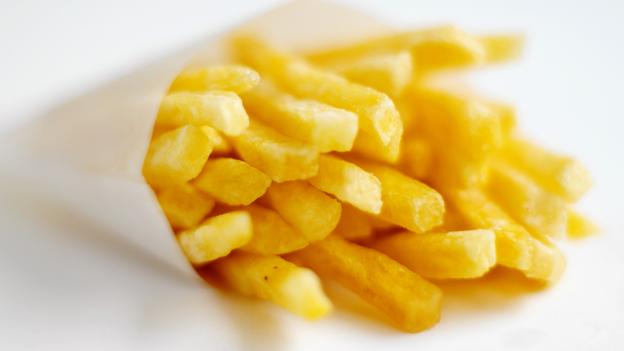(BBC) - How – and where – should you fry the ultimate chips? Veronique Greenwood takes a piping-hot plunge into the secret ways to create fried potato perfection.
The very best chips combine a crisp crust with a piping-hot, snowy-white interior – a delicious combination that arises when potatoes descend into a nice hot pool of oil. But how does the magic happen – and can food scientists find ways to improve the French fry?
Deep-frying has been described as "a pretty violent type of cooking”, and that's perfectly accurate. On contact with the oil, the moisture on the surface of the chip, or any other food item, immediately vaporises, sending out volcanic jets of steam that spatter the oil. The exterior of the chip is now dry, mummified into a hard crust. Within that shell, the temperature skyrockets and the water vapour that didn't make it to the surface in time to escape is trapped. It steams the potato flesh instead, giving it that fluffy quality that contrasts so nicely to the crunch.
This steaming process is why so many deep-fried foods are battered – onion rings, fish, corn dogs, Oreos, and Mars bars, to name just a very few. The shell must form instantaneously, or the vapour will continue to seep out, dampening the outer layer and desiccating the interior. At the same time, oil will seep in, making the food leaden and soggy. Most things can't form a solid shell fast enough. A starchy batter can, though, and the more the starch molecules latch onto each other, in a process called cross-linking, the more water is expelled and the crunchier the outcome. What’s more, starch has the potential to undergo the chemical reactions that cause browning and caramelising – key to the sweet notes in a good fried food.
Twice-fried
Chips aren’t cooked in batter, of course. They don’t need to be, because potatoes naturally have plenty of starches. The russet, a potato variety that's widely touted as the best for chips, has a high relative starch content and high density, which keeps the oil from penetrating too deeply. In the quest for the perfect chip, everything that follows after choice of potatoes has to do with fine-tuning this crust-and-steam process.
Most cooks and food scientists agree that the best chips are fried twice: first at a relatively low temperature, then at high heat, which is the go-round when the crust forms. (Although twice-fried isn't always standard: at McDonald's, the potato strips are blanched and then frozen, for instance, to be fried on demand.) One theory holds double-frying helps ensure the centre is cooked through – but a great post at The Burger Lab by J Kenji Lopez-Alt suggests otherwise. He performed some experiments, and found that chips that were cooked by boiling and then fried – instead of twice fried – did not crisp up, instead forming a paper-thin shell that split easily. The same was true of chips he cooked in the microwave before frying, so the problem wasn't that boiling added water.
In the end, Lopez-Alt found that the oil of the first frying changes the structure of the outer part of the chip. The water that's easy to boil away leaves, and the starches – released by the heat of the oil – combine with what's left to form a gel. That gel seeps around and stiffens the edges of the potato strip. When the hot oil of the second frying hits, the whole thing is primed to form that thicker crust and to have what remains of the moisture become steam. Boiling water cannot get hot enough to cause the gel to form.
Fluffy interior
But are twice-cooked chips the pinnacle? Heston Blumenthal of the Fat Duck thinks not. He famously concocted a recipe for cooking chips three times. The first time is a light boiling, followed by a stint in a vacuum chamber to remove the traces of water. The second is deep-frying at a relatively low temperature, and the third is the high-heat, crust-forming extravaganza. The chips you get at the end are so desiccated they have a glassy texture, with a fluffy interior – making them arguably the finest chips on the planet.
Nathan Myhrvold, former Microsoft CTO and author of the Modernist Cuisine cookbook has gone several levels of difficulty further with his recipe for "ultrasonic French fries”. It’s not exactly something you can try at home, but the result is apparently a "hugely satisfying crunch when you bite through the exterior” before yielding to "a centre of incredibly smooth mashed-potato consistency”, and a process he says could be automated by a food manufacturer.
The recipe vacuum seals chips in 2% brine before hitting them with ultrasound waves from the same device dentists and jewellers use, which cracks and blisters each chip with tiny bubbles and fissures. Next, the chips are vacuum-dried, to adjust the water content of the exterior, and then are briefly blanched in oil at 170C (340F) to tighten the network of starch molecules. After cooling, they are fried for a few minutes in hot oil at 190C (375F). The idea here is that the water turns to steam inside each minuscule bubble on a chip’s surface, forcing the bubbles to puff up.
Earth is not necessarily the best environment in the known Universe to fry chips, however. A few years ago, chemists John Lioumbas and Thodoris Karapantsios of the Aristotle University of Thessaloniki in Greece used a centrifuge facility in the Netherlands to show that chips cook best at three times Earth’s gravity – roughly the sort of conditions you might experience if you could live on Jupiter’s "surface”. The reason is that the water vapour produced inside the chip as it cooks behaves differently depending on the strength of gravity: at three times Earth’s gravity the water escapes in smaller clumps that accelerate the transfer of heat from the oil to the potato, contributing to a perfectly thick and crispy crust. Blumenthal – famous for using scientific equipment in his cooking – might want to consider incorporating his centrifuges into his formula in the future.
This all goes to show that the key to the perfect chip, whether you fry twice or thrice, on Earth or in space, is getting rid of the moisture at the right speed. Then, that magic dance of crispy and soft has a chance to develop its perfect rhythm.
www.ann.az
Follow us !











